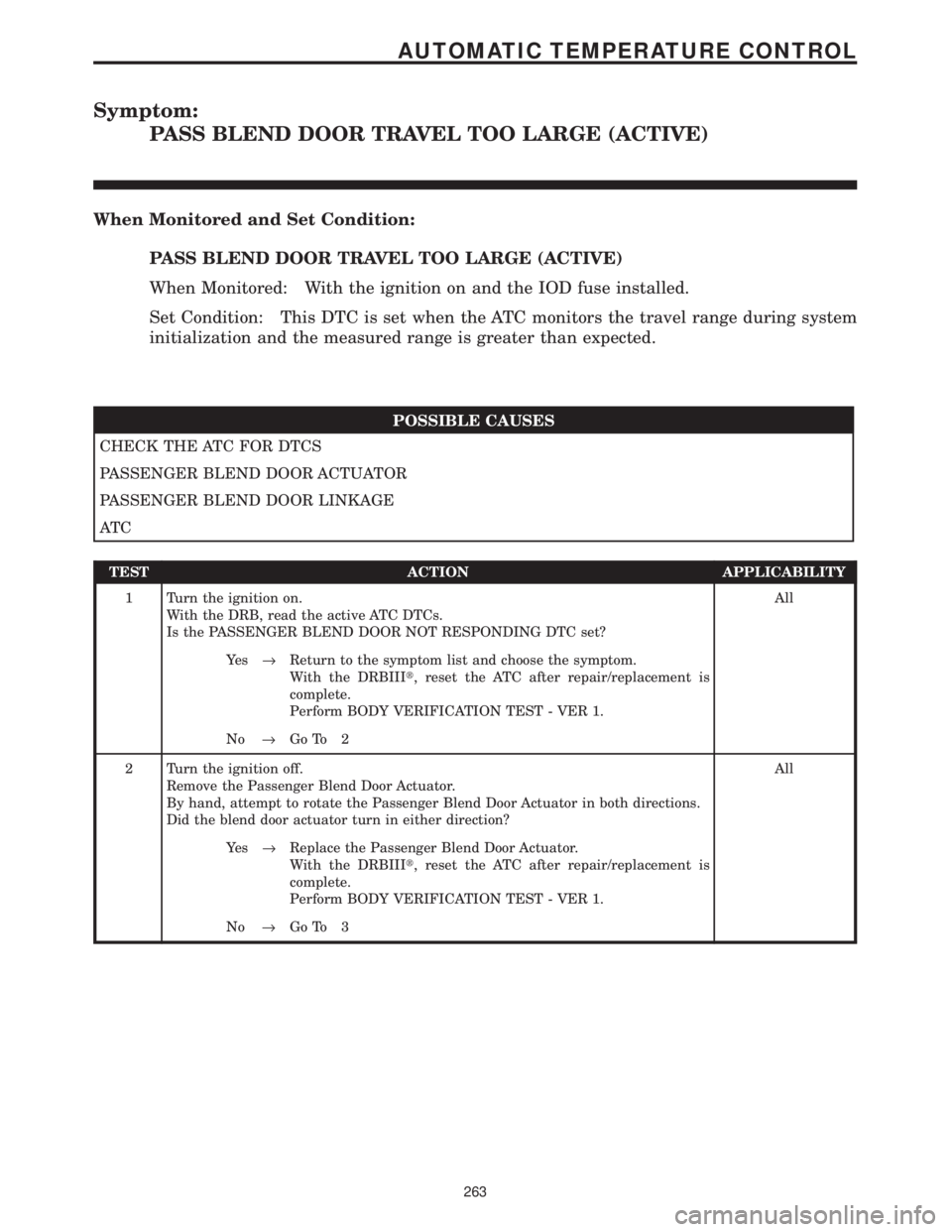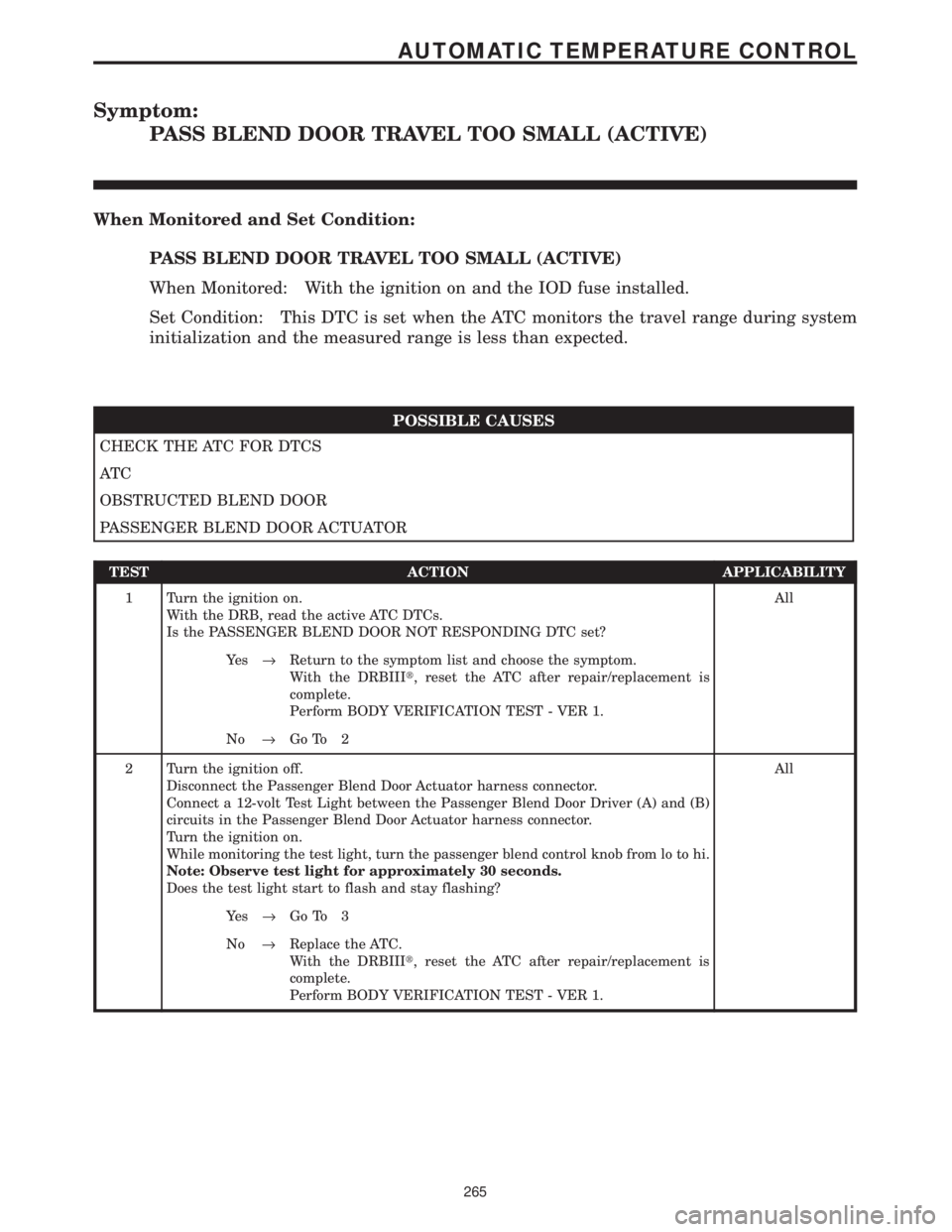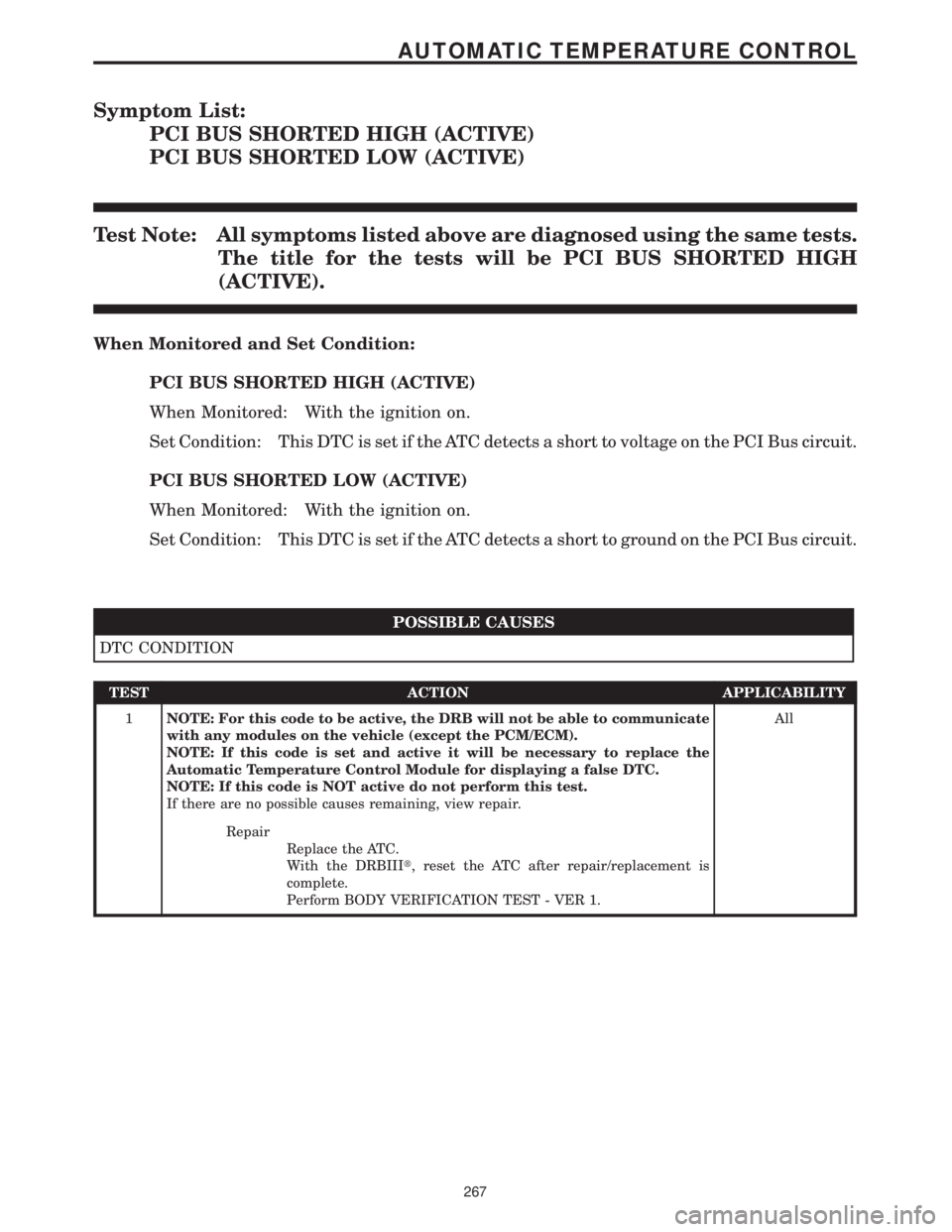Page 285 of 4284

Symptom:
FRONT MODE DOOR TRAVEL TOO SMALL (ACTIVE)
When Monitored and Set Condition:
FRONT MODE DOOR TRAVEL TOO SMALL (ACTIVE)
When Monitored: With the ignition on and the IOD fuse installed.
Set Condition: This DTC is set when the ATC monitors the travel range during system
initialization and the measured range is less than expected.
POSSIBLE CAUSES
CHECK THE ATC FOR DTCS
AT C
OBSTRUCTED MODE DOOR
MODE DOOR ACTUATOR
TEST ACTION APPLICABILITY
1 Turn the ignition on.
With the DRB, read the active ATC DTCs.
Is the FRONT MODE DOOR NOT RESPONDING DTC set?All
Ye s®Return to the symptom list and choose the symptom.
With the DRBIIIt, reset the ATC after repair/replacement is
complete.
Perform BODY VERIFICATION TEST - VER 1.
No®Go To 2
2 Turn the ignition off.
Disconnect the Mode Door Actuator harness connector.
Connect a 12-volt Test Light between the Mode Door Actuator harness connector
cavities.
Turn the ignition on.
While monitoring the test light, turn the mode control knob in each position.
Note: Observe test light for approximately 30 seconds.
Does the test light start to flash and stay flashing?All
Ye s®Go To 3
No®Replace the ATC.
With the DRBIIIt, reset the ATC after repair/replacement is
complete.
Perform BODY VERIFICATION TEST - VER 1.
256
AUTOMATIC TEMPERATURE CONTROL
Page 287 of 4284

Symptom:
INVALID CONDITIONS FOR COOLDOWN TEST, EVAP TEMPERA-
TURE TOO LOW
When Monitored and Set Condition:
INVALID CONDITIONS FOR COOLDOWN TEST, EVAP TEMPERATURE TOO
LOW
When Monitored: When executing the Cooldown Test.
Set Condition: This message will be displayed if the A/C - Heater Control Module sees
evaporator temperature below 12.7ÉC (55ÉF) when executing the Cooldown Test.
POSSIBLE CAUSES
EVAPORATOR TEMPERATURE TOO LOW
ATC DTC(S) PRESENT
CHECK THE PCM/ECM FOR DTCS
EVAPORATOR TEMPERATURE SENSOR
SENSOR GROUND CIRCUIT HIGH RESISTANCE
EVAPORATOR TEMPERATURE SENSOR SIGNAL CIRCUIT HIGH RESISTANCE
AUTOMATIC TEMPERATURE CONTROL
TEST ACTION APPLICABILITY
1CAUTION: The work area ambient temperature must be above 15.6ÉC (60ÉF)
to test A/C system operation.
Start the engine.
Turn the A/C off.
Turn the Blower on high. Allow the blower to run for 5 minutes to ensure that the
Evaporator Temperature Sensor temperature is above 12.7ÉC (55ÉF).
With the DRBIIIt, actuate the Cooldown Test.
Does the DRBIIItdisplay: Cooldown Test Too Cold To Start?All
Ye s®Go To 2
No®Perform additional testing as necessary.
Perform BODY VERIFICATION TEST - VER 1.
2CAUTION: The work area ambient temperature must be above 15.6ÉC (60ÉF)
to test A/C system operation.
Turn the ignition on.
With the DRBIIIt, read ATC DTCs.
Does the DRBIIItdisplay any ATC DTCs?All
Ye s®Return to the symptom list and choose the symptom(s). After the
repair is complete, with the DRBIIIt, erase the DTC(s). Cycle the
ignition switch. With the DRBIIIt, reset the ATC. With the
DRBIIIt, actuate the Cooldown Test.
Perform BODY VERIFICATION TEST - VER 1.
No®Go To 3
258
AUTOMATIC TEMPERATURE CONTROL
Page 288 of 4284

TEST ACTION APPLICABILITY
3CAUTION: The work area ambient temperature must be above 15.6ÉC (60ÉF)
to test A/C system operation.
Turn the ignition on.
With the DRBIIIt, check the PCM/ECM for DTCs.
Are any DTCs present?All
Ye s®Refer to the Powertrain Diagnostic information for the related
symptom(s). After the repair is complete, with the DRBIIIt, erase
the DTC(s). Cycle the ignition switch. With the DRBIIIt, reset the
ATC. With the DRBIIIt, accuate the Cooldown Test.
Perform BODY VERIFICATION TEST - VER 1.
No®Go To 4
4 Turn the ignition off.
Disconnect the Evaporator Temperature Sensor harness connector.
Turn the ignition on.
With the DRBIIItin Sensor Display, read the Evaporator Temperature Sensor
voltage.
Is the voltage above 4.9 volts?All
Ye s®Go To 5
No®Go To 6
5 Turn the ignition off.
Disconnect the Evaporator Temperature Sensor harness connector.
Connect a jumper wire between the Evaporator Temperature Sensor Signal circuit
and the Sensor Ground circuit at the Evaporator Temperature Sensor harness
connector.
Turn the ignition on.
With the DRBIIItin Sensor Display, read the Evaporator Temperature Sensor
voltage.
Is the voltage 0.0 volts?All
Ye s®Replace the Evaporator Temperature Sensor in accordance with
the Service Information. After the repair is complete, with the
DRBIIIt, reset the ATC. With the DRBIIIt, accuate the Cooldown
Test.
Perform BODY VERIFICATION TEST - VER 1.
No®Go To 6
6NOTE: Ensure that the voltmeter leads meet the terminals in the connector
and that there is good terminal to wire connection.
NOTE: Ensure the voltmeter leads are connected for positive polarity.
Back probe the Sensor Ground circuit between the Evaporator Temperature Sensor
harness connector and the ATC harness connector.
Turn the ignition on.
Is the voltage below 0.10 volt?All
Ye s®Go To 7
No®Repair the high resistance in the Sensor Ground circuit. After the
repair is complete, with the DRBIIIt, reset the ATC. With the
DRBIIIt, accuate the Cooldown Test.
Perform BODY VERIFICATION TEST - VER 1.
259
AUTOMATIC TEMPERATURE CONTROL
INVALID CONDITIONS FOR COOLDOWN TEST, EVAP TEMPERATURE
TOO LOW Ð
Continued
Page 289 of 4284
TEST ACTION APPLICABILITY
7NOTE: Ensure the voltmeter leads meet the terminals in the connector and
that there is good terminal to wire connection.
NOTE: Ensure the voltmeter leads are connected for positive polarity
Back probe the Evaporator Temperature Sensor Signal circuit between the Evapo-
rator Temperature Sensor harness connector and the ATC harness connector.
Turn the ignition on.
Is the voltage below 0.10 volt?All
Ye s®Replace the Automatic Temperature Control. After the repair is
complete, with the DRBIIIt, reset the ATC. With the DRBIIIt,
accuate the Cooldown Test.
Perform BODY VERIFICATION TEST - VER 1.
No®Repair the high resistance in the Evaporator Temperature Sensor
Signal circuit. After the repair is complete, with the DRBIIIt,
reset the ATC. With the DRBIIIt, accuate the Cooldown Test.
Perform BODY VERIFICATION TEST - VER 1.
260
AUTOMATIC TEMPERATURE CONTROL
INVALID CONDITIONS FOR COOLDOWN TEST, EVAP TEMPERATURE
TOO LOW Ð
Continued
Page 290 of 4284

Symptom:
PASS BLEND DOOR NOT RESPONDING (ACTIVE)
When Monitored and Set Condition:
PASS BLEND DOOR NOT RESPONDING (ACTIVE)
When Monitored: With the ignition on and the IOD fuse installed.
Set Condition: This DTC is set if the ATC does not receive feedback pulses within 5
seconds of the drive voltage being applied.
POSSIBLE CAUSES
PASSENGER BLEND DOOR DRIVER CIRCUIT (A) SHORTED TO GROUND
PASSENGER BLEND DOOR DRIVER CIRCUIT (B) SHORTED TO GROUND
PASSENGER BLEND DOOR DRIVER CIRCUITS (A) AND (B) SHORTED TOGETHER
PASSENGER BLEND DOOR DRIVER CIRCUIT (A) OPEN
PASSENGER BLEND DOOR DRIVER CIRCUIT (B) OPEN
AT C
PASSENGER BLEND DOOR ACTUATOR
TEST ACTION APPLICABILITY
1 Turn the ignition off.
Disconnect the ATC C1 harness connector.
Measure the resistance between ground and the Passenger Blend Door Driver (A)
circuit.
Is the resistance above 100k ohms?All
Ye s®Go To 2
No®Repair the Passenger Blend Door Driver (A) circuit for a short to
ground.
With the DRBIIIt, reset the ATC after repair/replacement is
complete.
Perform BODY VERIFICATION TEST - VER 1.
2 Turn the ignition off.
Disconnect the ATC C1 harness connector.
Measure the resistance between ground and the Passenger Blend Door Driver (B)
circuit.
Is the resistance above 100k ohms?All
Ye s®Go To 3
No®Repair the Passenger Blend Door Driver (B) circuit for a short to
ground.
With the DRBIIIt, reset the ATC after repair/replacement is
complete.
Perform BODY VERIFICATION TEST - VER 1.
261
AUTOMATIC TEMPERATURE CONTROL
Page 292 of 4284

Symptom:
PASS BLEND DOOR TRAVEL TOO LARGE (ACTIVE)
When Monitored and Set Condition:
PASS BLEND DOOR TRAVEL TOO LARGE (ACTIVE)
When Monitored: With the ignition on and the IOD fuse installed.
Set Condition: This DTC is set when the ATC monitors the travel range during system
initialization and the measured range is greater than expected.
POSSIBLE CAUSES
CHECK THE ATC FOR DTCS
PASSENGER BLEND DOOR ACTUATOR
PASSENGER BLEND DOOR LINKAGE
AT C
TEST ACTION APPLICABILITY
1 Turn the ignition on.
With the DRB, read the active ATC DTCs.
Is the PASSENGER BLEND DOOR NOT RESPONDING DTC set?All
Ye s®Return to the symptom list and choose the symptom.
With the DRBIIIt, reset the ATC after repair/replacement is
complete.
Perform BODY VERIFICATION TEST - VER 1.
No®Go To 2
2 Turn the ignition off.
Remove the Passenger Blend Door Actuator.
By hand, attempt to rotate the Passenger Blend Door Actuator in both directions.
Did the blend door actuator turn in either direction?All
Ye s®Replace the Passenger Blend Door Actuator.
With the DRBIIIt, reset the ATC after repair/replacement is
complete.
Perform BODY VERIFICATION TEST - VER 1.
No®Go To 3
263
AUTOMATIC TEMPERATURE CONTROL
Page 294 of 4284

Symptom:
PASS BLEND DOOR TRAVEL TOO SMALL (ACTIVE)
When Monitored and Set Condition:
PASS BLEND DOOR TRAVEL TOO SMALL (ACTIVE)
When Monitored: With the ignition on and the IOD fuse installed.
Set Condition: This DTC is set when the ATC monitors the travel range during system
initialization and the measured range is less than expected.
POSSIBLE CAUSES
CHECK THE ATC FOR DTCS
AT C
OBSTRUCTED BLEND DOOR
PASSENGER BLEND DOOR ACTUATOR
TEST ACTION APPLICABILITY
1 Turn the ignition on.
With the DRB, read the active ATC DTCs.
Is the PASSENGER BLEND DOOR NOT RESPONDING DTC set?All
Ye s®Return to the symptom list and choose the symptom.
With the DRBIIIt, reset the ATC after repair/replacement is
complete.
Perform BODY VERIFICATION TEST - VER 1.
No®Go To 2
2 Turn the ignition off.
Disconnect the Passenger Blend Door Actuator harness connector.
Connect a 12-volt Test Light between the Passenger Blend Door Driver (A) and (B)
circuits in the Passenger Blend Door Actuator harness connector.
Turn the ignition on.
While monitoring the test light, turn the passenger blend control knob from lo to hi.
Note: Observe test light for approximately 30 seconds.
Does the test light start to flash and stay flashing?All
Ye s®Go To 3
No®Replace the ATC.
With the DRBIIIt, reset the ATC after repair/replacement is
complete.
Perform BODY VERIFICATION TEST - VER 1.
265
AUTOMATIC TEMPERATURE CONTROL
Page 296 of 4284

Symptom List:
PCI BUS SHORTED HIGH (ACTIVE)
PCI BUS SHORTED LOW (ACTIVE)
Test Note: All symptoms listed above are diagnosed using the same tests.
The title for the tests will be PCI BUS SHORTED HIGH
(ACTIVE).
When Monitored and Set Condition:
PCI BUS SHORTED HIGH (ACTIVE)
When Monitored: With the ignition on.
Set Condition: This DTC is set if the ATC detects a short to voltage on the PCI Bus circuit.
PCI BUS SHORTED LOW (ACTIVE)
When Monitored: With the ignition on.
Set Condition: This DTC is set if the ATC detects a short to ground on the PCI Bus circuit.
POSSIBLE CAUSES
DTC CONDITION
TEST ACTION APPLICABILITY
1NOTE: For this code to be active, the DRB will not be able to communicate
with any modules on the vehicle (except the PCM/ECM).
NOTE: If this code is set and active it will be necessary to replace the
Automatic Temperature Control Module for displaying a false DTC.
NOTE: If this code is NOT active do not perform this test.
If there are no possible causes remaining, view repair.All
Repair
Replace the ATC.
With the DRBIIIt, reset the ATC after repair/replacement is
complete.
Perform BODY VERIFICATION TEST - VER 1.
267
AUTOMATIC TEMPERATURE CONTROL